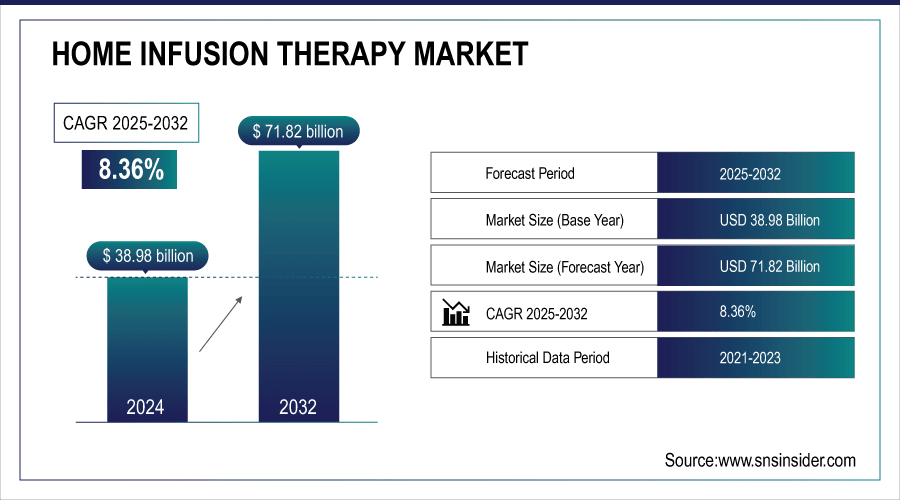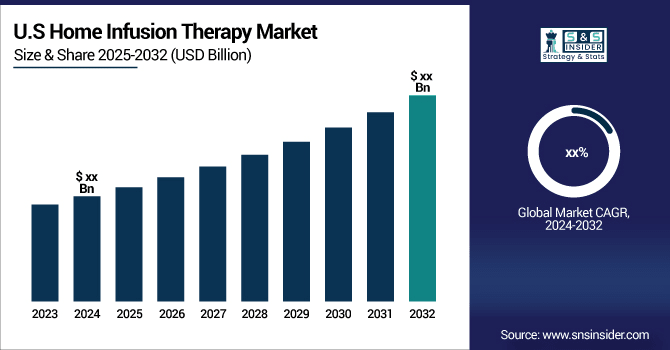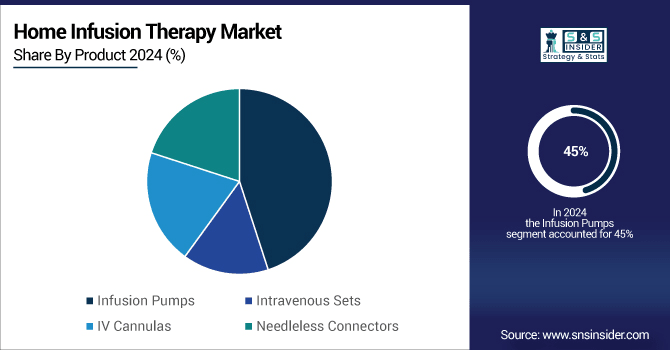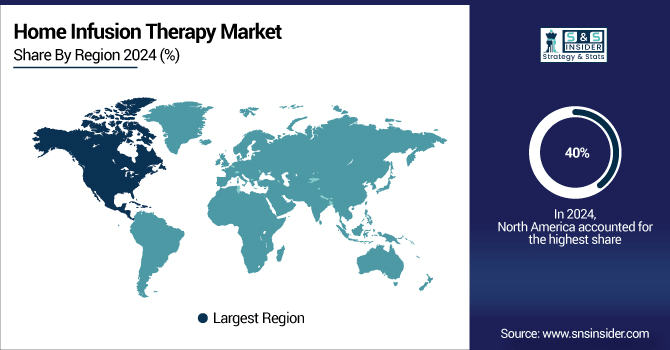Home Infusion Therapy Market Report Scope & Overview:
The Home Infusion Therapy Market size was valued at USD 38.98 Billion in 2024 and is expected to reach USD 71.82 Billion by 2032, growing at a CAGR of 8.36% over the forecast period 2025-2032.
The Home Infusion Therapy market is witnessing substantial growth, primarily fueled by the rising prevalence of chronic diseases and an increasing demand for patient-centric healthcare solutions. The Centers for Disease Control and Prevention (CDC) reports that nearly 60% of adults in the United States live with at least one chronic disease, including heart disease, diabetes, and respiratory conditions. This statistic highlights the urgent need for effective home healthcare solutions that empower patients to manage their conditions independently, thereby reducing the frequency of hospital visits and minimizing the associated healthcare costs. Chronic diseases often necessitate long-term treatments that can be cumbersome and challenging for patients to receive in traditional healthcare settings.
Moreover, advancements in technology have significantly contributed to the growth of the Home Infusion Therapy market. Innovations in infusion devices and drug delivery systems, such as smart pumps equipped with monitoring capabilities, have enhanced patient safety and treatment efficacy. These technological improvements have made it easier for healthcare professionals to oversee home infusion therapy remotely, ensuring timely interventions when necessary. For instance, the integration of telehealth services has enabled healthcare providers to conduct virtual consultations, monitor patient conditions, and adjust treatment plans in real-time, further promoting the adoption of home infusion therapy. Government policies and reimbursement structures are also pivotal in shaping the market landscape. The Centers for Medicare & Medicaid Services (CMS) have implemented various initiatives aimed at expanding coverage for home health services, which directly benefits home infusion therapy. Increased reimbursement rates and simplified regulatory requirements have made it more accessible for patients to receive infusion therapies at home. As a result, healthcare providers are more likely to offer these services, knowing that they are supported by favorable reimbursement frameworks.

To Get More Information On Home Infusion Therapy Market - Request Free Sample Report
Home Infusion Therapy Market Highlights
-
Increasing prevalence of chronic diseases such as diabetes, cancer, and cardiovascular disorders is driving strong demand for home infusion therapy services.
-
Technological advancements in infusion devices, including smart pumps with remote monitoring capabilities, are enhancing patient safety and treatment efficacy.
-
Integration of telehealth solutions enables healthcare providers to monitor patients remotely, conduct virtual consultations, and adjust therapy in real-time, promoting adoption.
-
Strict regulatory requirements and inconsistent insurance reimbursement policies can limit market expansion and patient access to home infusion therapy.
-
The aging population is creating substantial growth opportunities for home healthcare services, including infusion therapy.
-
Anti-infective therapy holds a significant market share due to rising prevalence of infectious diseases and antibiotic-resistant infections.
-
North America leads the market with advanced healthcare infrastructure, favorable government policies, and growing elderly population driving increased adoption of home infusion services.
-
Favorable reimbursement frameworks and government initiatives, such as CMS programs, support the expansion and accessibility of home infusion therapy.

Home Infusion Therapy Market Drivers:
-
Increasing Incidence of Chronic Conditions Such as Diabetes, Cancer, And Cardiovascular Diseases Drives the Demand for Home Infusion Therapy
The rising prevalence of chronic diseases, including diabetes, cancer, and cardiovascular disorders, is a key driver of the home infusion therapy market. Globally, chronic conditions account for approximately 71% of all deaths, according to the World Health Organization (WHO), highlighting the urgent need for continuous and effective patient care. Diabetes alone affects over 537 million adults worldwide as of 2023, with the International Diabetes Federation projecting this number to rise to 643 million by 2030. Similarly, cardiovascular diseases remain the leading cause of death globally, responsible for an estimated 18.6 million fatalities annually. Cancer prevalence is also increasing, with the International Agency for Research on Cancer reporting over 19.3 million new cases in 2023.
Home infusion therapy allows for the administration of essential medications such as insulin, chemotherapy agents, and cardiovascular drugs in a home setting, reducing hospital visits and improving patient quality of life. The convenience and personalized care offered by home infusion are particularly beneficial for elderly patients, who often manage multiple chronic conditions simultaneously. In the United States, around 30% of adults aged 65 and older have two or more chronic diseases, which further drives demand for home-based healthcare solutions. As chronic disease prevalence continues to rise, home infusion therapy is poised for sustained growth due to its efficacy, convenience, and ability to optimize healthcare resources.
-
Innovations in Infusion Devices and Drug Delivery Systems Enhance Patient Safety and Comfort, Contributing to The Growth of Home Infusion Therapy Services
Home Infusion Therapy Market Restraints:
-
Strict Regulatory Requirements and Compliance Issues Can Hinder the Adoption and Expansion of Home Infusion Therapy Services, Particularly in Varying Markets.
Strict regulatory requirements and compliance challenges remain significant restraints in the growth of the home infusion therapy market. Different countries and regions impose varying standards for the administration, storage, and monitoring of infusion therapies, making it difficult for providers to maintain uniform practices globally. Compliance with agencies such as the U.S. Food and Drug Administration (FDA), the European Medicines Agency (EMA), and local health authorities requires rigorous documentation, frequent audits, and adherence to strict safety protocols.
Additionally, providers must ensure that all healthcare professionals administering home infusion are appropriately trained and certified, which can increase operational costs and limit rapid scaling. Variations in legal frameworks, such as differing policies on telehealth monitoring, remote patient management, and reimbursement eligibility, further complicate market expansion. Failure to comply with these regulations can result in penalties, legal liabilities, or suspension of services, discouraging smaller providers from entering the market. These regulatory complexities and compliance burdens create operational challenges that slow adoption rates, particularly in emerging markets where infrastructure and oversight may be limited.
-
Inadequate Reimbursement for Home Infusion Therapy from Insurance Providers May Restrict Patient Access and Limit Market Growth.
Home Infusion Therapy Market Opportunities:
-
An Aging Population Increases the Need for Home Healthcare Services, Including Infusion Therapy, Presenting Significant Market Growth Potential.
-
The Integration of Telehealth into Home Healthcare Can Facilitate Better Monitoring and Management of Infusion Therapies, Improving Patient Outcomes and Driving Demand.
Global Home Infusion Therapy Market Segmentation Insights
By Product
In the Home Infusion Therapy Market, Infusion Pumps held a substantial market share of 45% in 2024. Infusion pumps are critical in delivering precise amounts of medication and nutrients to patients, ensuring accurate dosing and reducing the risk of errors. The demand for advanced infusion pumps has surged due to their ability to improve patient outcomes and enhance safety in home healthcare settings. A report by the FDA indicated that the use of infusion pumps has been associated with a 50% reduction in medication administration errors, driving their adoption among healthcare providers and patients alike. Furthermore, advancements in technology, such as the integration of smart infusion systems and remote monitoring capabilities, have positioned infusion pumps as the preferred choice for home infusion therapy, contributing to their dominance in the market.

By Application
Anti-infective therapy accounted for 35% of the market share in 2024. The high prevalence of infectious diseases, coupled with the rising incidence of antibiotic-resistant infections, has driven the demand for effective anti-infective treatments delivered in a home setting. According to the World Health Organization (WHO), antimicrobial resistance (AMR) is a growing global health threat, causing an estimated 700,000 deaths annually, with projections suggesting that this number could rise to 10 million by 2050 if not addressed. This alarming statistic highlights the urgent need for effective anti-infective therapies, further stimulating market growth. Home infusion allows for continuous and consistent delivery of these therapies, reducing hospital stays and improving patient quality of life, which is crucial in managing infections.
Home Infusion Therapy Market Regional Outlook
North America Leads Home Infusion Therapy Market
In 2024, North America was the dominant region in the home infusion therapy market, holding a market share of approximately 40%. This dominance can be attributed to several factors, including advanced healthcare infrastructure, a high prevalence of chronic diseases, and a rapidly growing elderly population in the region. According to the U.S. Census Bureau, the population aged 65 and older is projected to reach about 95 million by 2060, nearly doubling from 52 million in 2021. This demographic shift is expected to significantly increase the demand for home healthcare services, including home infusion therapy. Recent statistics from the National Center for Health Statistics indicate that approximately 30% of older adults in the U.S. manage two or more chronic conditions, further driving the need for effective home healthcare solutions. Additionally, favorable reimbursement policies and government initiatives, such as those from the Centers for Medicare & Medicaid Services (CMS), have expanded coverage for home health services, allowing more patients to access home infusion therapy.
-
In 2023, CMS reported that home health expenditures reached USD 100 billion, reflecting a 15% increase compared to the previous year. This trend reinforces North America’s position as a leader in the home infusion therapy market, with significant growth potential in the coming years.

Get Customized Report as Per Your Business Requirement - Enquiry Now
Home Infusion Therapy Market Key Players
-
CVS/Coram
-
Option Care Health
-
BriovaRx/Diplomat (UnitedHealth Optum)
-
PharMerica
-
Fresenius Kabi
-
ICU Medical, Inc.
-
B. Braun Melsungen AG
-
BD (Becton, Dickinson, and Company)
-
Caesarea Medical Electronics
-
Smith’s Medical
-
JMS Co. Ltd.
-
Medtronic
-
Halyard Health (now part of Owens & Minor)
-
Zyno Medical
-
Alaris Medical Systems (part of BD)
-
Calea
-
Nipro Medical Corporation
-
HMC (Health Management Corporation)
-
Pall Corporation
Home Infusion Therapy Market Competitive Landscape
Baxter International Inc., headquartered in Deerfield, Illinois, is a global healthcare company specializing in medical technologies and therapies for complex and chronic conditions. Founded in 1931, Baxter pioneered intravenous (IV) solutions and has since expanded into renal care, infusion therapies, anesthesia, and surgical products. In 2023, the company reported global net sales of $14.8 billion, operating across Medical Products and Therapies, Healthcare Systems and Technologies, and Pharmaceuticals. Baxter has strengthened its portfolio through acquisitions like Gambro and Hill-Rom, while focusing on core medical technologies after divesting its biopharma solutions business. Its mission is to save and sustain lives worldwide.
-
In June 2023, an American healthcare company, Baxter International announced the Progressa+ Next Gen ICU bed that is designed to meet the emergency needs of patients at their homes. This technology facilitates the task performance of nurses at the same time promotes therapy at home.
Fresenius Kabi, a subsidiary of Fresenius SE & Co. KGaA, is a global healthcare company headquartered in Bad Homburg, Germany, specializing in lifesaving medicines and technologies for infusion, transfusion, and clinical nutrition. Established in 1999, the company focuses on providing intravenous drugs, infusion therapies, and medical devices to hospitals and healthcare providers worldwide. In 2023, Fresenius Kabi reported revenues exceeding €9 billion, driven by strong demand for critical care and oncology therapies. The company emphasizes innovation, quality, and patient safety, while expanding its global footprint through strategic investments and partnerships to enhance healthcare access in emerging and developed markets.
-
In May 2023, Fresenius Kabi, a global healthcare firm, established an agreement with Premier, Inc., an American healthcare company that resulted in the capability to offer pricing and term stipulations for the Ivenix Infusion System.
| Report Attributes | Details |
|---|---|
| Market Size in 2024 | US$ 38.98 Billion |
| Market Size by 2032 | US$ 71.82 Billion |
| CAGR | CAGR of 8.36% From 2025 to 2032 |
| Base Year | 2024 |
| Forecast Period | 2025-2032 |
| Historical Data | 2021-2023 |
| Report Scope & Coverage | Market Size, Segments Analysis, Competitive Landscape, Regional Analysis, DROC & SWOT Analysis, Forecast Outlook |
| Key Segments | •By Product (Infusion Pumps, Intravenous Sets, IV Cannulas, Needleless Connectors), •By Application (Anti-Infective, Endocrinology, Chemotherapy, Enteral Nutrition, Parenteral Nutrition, Others) •By Route of Administration (Intramuscular, Subcutaneously, Epidural) |
| Regional Analysis/Coverage | North America (US, Canada, Mexico), Europe (Eastern Europe [Poland, Romania, Hungary, Turkey, Rest of Eastern Europe] Western Europe] Germany, France, UK, Italy, Spain, Netherlands, Switzerland, Austria, Rest of Western Europe]), Asia Pacific (China, India, Japan, South Korea, Vietnam, Singapore, Australia, Rest of Asia Pacific), Middle East & Africa (Middle East [UAE, Egypt, Saudi Arabia, Qatar, Rest of Middle East], Africa [Nigeria, South Africa, Rest of Africa], Latin America (Brazil, Argentina, Colombia, Rest of Latin America) |
| Company Profiles | CVS/Coram, Option Care Health, BriovaRx/Diplomat (UnitedHealth Optum), PharMerica, Fresenius Kabi, ICU Medical, Inc., B. Braun Melsungen AG, Baxter, BD, Caesarea Medical Electronics, Smiths Medical, and Terumo Corporation, as well as JMS Co. Ltd. |

